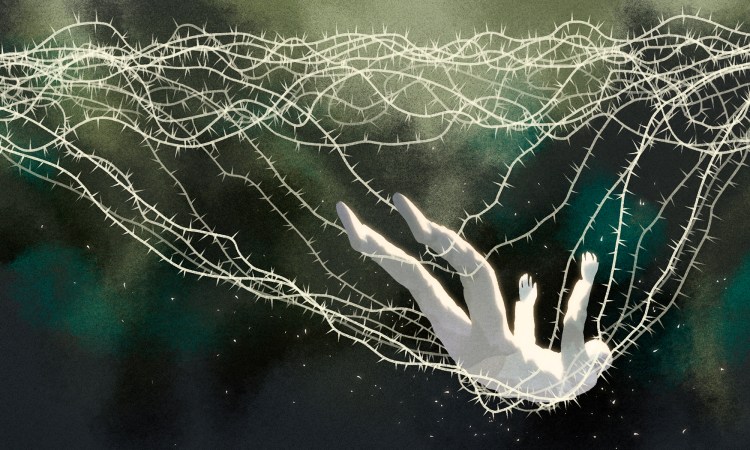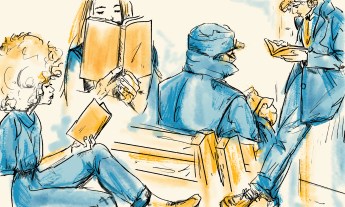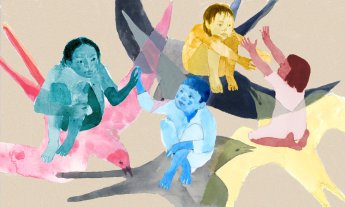
For over two decades, Christian Picciolini, who once led a white supremacist organization, has worked as a peace advocate and “hate breaker”, helping disengage people — including neo-Nazis, white nationalists and Islamist jihadists — from extremist groups.
In his new book Breaking Hate, he draws on the experiences of people that he’s met, revealing how violent movements target the most vulnerable and exploit their human desires and how the right interventions can save lives. Below, he shares the story of Daniel from Kentucky.
Turmoil filled Daniel’s every day from the moment he was born. His father, Bud, who spent most hours at home on the porch drunk, wasn’t much help to his overwhelmed mother, Janet. When Janet sought Bud’s support with their four kids, the alcohol and drugs he took to quiet his chronic back pain exacerbated the nastiness.
Daniel’s parents emotionally abused each other throughout his childhood. His father claimed he couldn’t work because of a back injury, while Janet worked multiple minimum-wage bar jobs to keep the family above Louisville’s poverty line. It was an uphill battle, since their part of rural Kentucky was already one of the most impoverished areas with the highest unemployment rates in America.
Daniel never attempted to make friends with anyone but the white kids at school, and Bud showed him how to defend himself with his fists and launch the N-word as a weapon.
Some of Daniel’s “potholes” growing up were obvious: poverty, lack of opportunity and questionable role models. Others were deep, like the emotional abuse he was a constant witness to between his parents. If Daniel was fortunate enough to evade one pitfall, the likelihood of him stumbling into others, which seemed to multiply by the day, was almost inevitable. Finding the same comfort that kept her husband numb, Janet also turned to alcohol and drugs to cope with life’s demands.
Daniel’s childhood wasn’t all misery, though. Love occasionally revealed itself; sometimes, after a few shots of bourbon, Bud might pull Janet in for a kiss. Daniel would pretend to be embarrassed, but it tickled him to glimpse affection. He hoped it would be the one time their chemical-fueled romance would not turn toxic. But it always did.
There were after-school programs and aid organizations that Daniel’s parents could have leveraged but didn’t. Their corner of Louisville comprised poor black kids and Southern whites who’d become conditioned, consciously or not, to maintain segregation, so he never attempted to make friends with anyone but the white kids at school. Bud showed his son how to defend himself with his fists and launch the N-word as a weapon.
Before Daniel reached high school, Bud and Janet split up. It was a relief to not live with the constant anxiety of shouting matches, but not having Bud there left Daniel confused and angry. Janet’s three jobs meant she was seldom home, and when she was, she was usually drunk and with random men.
A year after the split, doctors diagnosed Bud with pancreatic cancer, and Janet let him live out his last months with her and their kids in a tiny apartment. For five months, Daniel watched his father, the only man who’d ever shown concern for him, grow sicker and weaker. It was painful for Daniel, but even though his mother continued dating other men, he also witnessed an intimacy and tenderness between his parents he’d not seen before.
At 17, Daniel dropped out of school to find work, proud to help support his family. He loved them, no matter how flawed they were. “I care about them more than anything,” he later told me. “They’re all I got.”
One morning when Bud wasn’t snoring like he usually did, Daniel knew death had claimed him. He didn’t take his passing well. A short time later, Janet committed to getting clean. It was the most difficult challenge she’d face, but she wanted to be strong for her children and a new grandson. Although Daniel never liked his sister’s Black ex-boyfriend, he loved having a baby nephew around. Daniel remained close with his nephew and sister in his teen years, but he also veered toward street fighting and old-fashioned bigotry. He cropped his hair short like the rowdy neo-Nazi skinheads he spied across the Ohio River in Cincinnati.
The empowerment he experienced through associating with skinheads gave him permission to express his grievances and the directive to focus his rage on an enemy.
When Janet came home with an old flame a few weeks before she entered detox, Daniel melted down at the sight of the Black man with his mother. The same lover had abused Janet in the past. During an earlier affair Janet had with the same man, Daniel witnessed him slap her, shoving her into a door and knocking it from its hinges. Now, four years after the violent incident and just shy of Daniel’s 18th birthday, Janet was back with him. Furious at the sight of them together, Daniel beat the man until his knuckles bled.
A week later, Daniel went looking for the gang of white-power skinheads from across the river and found them. The older men welcomed him like a son. It didn’t take long to complete the “tough look” Daniel admired from afar, one that included swastikas and other hate imagery tattooed on his arms, neck and face.
Though it’s likely that Daniel’s ideological base was rooted in his father’s bigotry — and the racism that haunts Kentucky and other regions of the former Confederacy — his pre-radicalization trajectory took many sharp turns early in his adolescence. But I believe it was the emotional trauma of seeing his mother belittled by his father that sent him into a tailspin toward extremism. The empowerment he experienced through his association with violent skinheads provided him with what he felt was “permission” to express his grievances and the directive to focus his rage on a tangible enemy — one he learned to blame for his pain.
Whatever their reasons, Daniel and his family could not access the proper resources to help them nor did they have the knowledge that help existed for them. Like many families, they felt stuck and the more they struggled, the deeper they sank. To control the abuse they endured, they learned to become abusers themselves — abusers of drugs, of one another.
Extremists see vulnerable people like Daniel as easy marks for recruitment to their cause. Their unstable conditions make them prone to accepting (empty) promises of paradise on Earth or a return to past greatness. They exploit their frustrations and manipulate them through their uncertainties: lack of meaningful employment, immigration and the outsourcing they claim threatens those jobs and a family’s security, as well as the “elites” they claim have betrayed people into these dismal conditions.
In my work with all kinds of extremists, I’ve noticed that those at risk of losing something are often more susceptible to radicalization.
In my work with all kinds of extremists, I’ve noticed that those at risk of losing something are often more susceptible to radicalization than those who don’t have discernible means or who feel overwhelmed by everyday survival. Similarly, Eric Hoffer — the longshoreman turned influential social philosopher — states in The True Believer, his seminal book on mass movements, that people on the cusp of socioeconomic classes are the most vulnerable to recruitment. Fear of loss, whether it’s of status, a job, a loved one, freedom or privilege, makes individuals living on the edge of society easier to seduce.
Arguing away hate in extremists doesn’t work. It often has the negative effect of aggravating maladaptive behaviors in people who already feel isolated. Since they’re protecting what little control they feel they have, they are willing to do anything to keep it. We must tackle extremism like a public health crisis to build human resilience if we hope to defeat it in the long term.
Repairing the kind of abusive feedback loop experienced by Daniel’s family requires ongoing support and extraordinary patience. Over time, counselors and cognitive-behavioral therapists can help teach life management skills and thought processes, but this isn’t always easy when someone’s ability to access the support they need is out of reach.
Often, the more economically challenged or isolated a community is, the more difficult it can be to access necessary resources like counselors, job trainers, mental health therapists, life coaches or an education. For Daniel and for others in similar situations, it also requires gaining new perspective from their journey to see their mistakes for what they were — learned behaviors — without becoming so overwhelmed by shame that they give up on repairing them.
At first, Daniel found that becoming a neo-Nazi skinhead masked his emotional pain and fulfilled his need for a “stable” community. It was a place to belong and feel accepted. The strict ideology offered him false solace, and his new family’s routine of street violence filled him with the perception of power — the kind he’d seen other men around him wield. Daniel felt a semblance of control for the first time.
When I became a neo-Nazi skinhead over three decades ago, nothing filled me with more confidence and pride than the uniform I wore: a shaved head, steel-toed Dr. Martens boots with white straight laces, a black nylon bomber jacket loaded with patches and tattoos — swastikas, Celtic crosses and Viking runes — inked into my skin. Like Daniel, I wore pride on my sleeves, figuratively and literally. The generation of militant white supremacists I fought alongside in the 1980s and ’90s was difficult to miss coming from a mile away.
Today, hate has largely camouflaged itself and moved underground. Following the strategy of white supremacist leaders in the early 1990s to mainstream their cause, this more visible brand of white-supremacist extremism is no longer the norm in the US.
Efforts seek to legitimize white supremacy as a form of racial pride, emphasizing the notion of reverse racism.
Old racist canards about “global Jewish control” have become buffed and polished to sound more like conservative foreign policies. Terms like “globalist” and “global elite” replaced “Zionist” and “Jew”. Cries of “White power!” became whispers of “white pride.” Holocaust deniers resurfaced as revisionist historians, labeling themselves “skeptics” to influence “race realist” movements hiding in pseudo-academic circles on college campuses. Calls to “save the white race” have given way to the deceptive oath of “We the People.”
Efforts seek to legitimize white supremacy as a form of racial pride, emphasizing the notion of reverse racism — the discredited hypothesis that claims historically privileged groups (whites) are frequently made the targets of racism by policies accounting for racial disparities and inequities. Co-opting the message of Black Lives Matter, the slogan “White Lives Matter” has gained favor among white supremacists over the more traditional chant of “Sieg heil.”
This metastasis from overt white power to “identity politics” has taken time. But crafting a less recognizable poison for the disillusioned white masses to swallow became easier when Barack Obama became America’s first Black president. That’s when paranoia among some whites exploded, making them easier to recruit. During President Obama’s first term in office, a new version of the white-supremacist movement of my youth — a variety that emphasized pride and left the hateful undergirding more implicit — called white nationalism began to rear its ugly head.
Today’s white supremacists claim to stand for the rights of marginalized whites to sway vulnerable, wayward youth into becoming new recruits.
Mainstream whites on the conservative edge of the political spectrum, including libertarian free speech and small-government aficionados, found white supremacy more palatable in its new form. Its supporters — often college-educated, privileged, young white men (and an increasing number of women) — started being exposed to alt-right ideas through networks like Twitter, YouTube, Facebook, 4chan, Reddit and Gab, where sympathizers revel in the denigration of multiculturalism, feminism and immigration, converging on the notion that white identity and the preservation of white racial homogeneity is of sacred importance.
Hiding in plain sight, this hate movement has built itself on the same foundation and long-standing principles of old-fashioned American white supremacy. Feigning innocence, their leaders peddle more sanitized extremist messages while arguing that they don’t hate anyone. They claim to stand for the rights of marginalized whites to sway vulnerable, wayward youth into becoming new recruits.
Skinhead groups like the Hammerskins that Daniel joined (and I once helped lead) are some of the last remaining holdouts from the movement’s transition from Doc Martens boots to bespoke suits, and even most of them have now gone underground. While I know that some of the old-guard white supremacists grew up, found their way out and ultimately chose to walk a better path, I also know most did not.
We are only now beginning to discover the recesses where these others have disappeared to. I still remember many of the faces I once knew, which sometimes come to me in my thoughts when I least expect them — a familiar smirk over my shoulder in the dusty reflection of a shop window or on the surface of a puddle, rippling from the wind, and then they disappear — and I wonder what violence they might still unleash.
Excerpted from the new book Breaking Hate: Confronting the New Culture of Extremism by Christian Picciolini. Reprinted with permission from Hachette Books, a division of Hachette Book Group, Inc. Copyright © 2020 by Christian Picciolini.
Watch his TEDxMileHigh Talk now:











